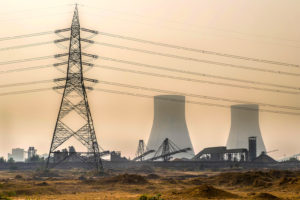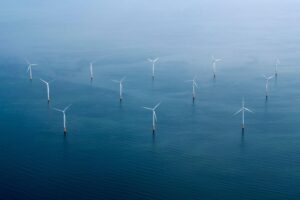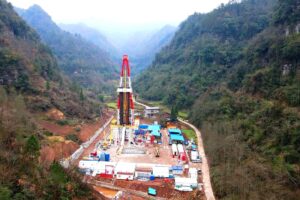Episode 101: Music, Literature, and Climate Action
Episode 101 of Citizens’ Climate Radio highlights two powerful voices shaping the climate conversation: Elise Silvestri, a college student and musician passionate about climate justice, and Linda Sue Park, an award-winning author using storytelling to inspire young activists.
Elise, who has worked on the Citizens’ Climate Radio team for six months, shares her journey through eco-anxiety, activism, and music production. She believes that addressing the climate crisis requires radical imagination — envisioning the world we want to create rather than just reacting to the crises around us. Elise also introduces us to Linda Sue Park, whose latest book, Gracie Under the Waves, follows a young snorkeling enthusiast as she discovers the urgent need for ocean conservation.
Listen Now!
Facing Eco Anxiety with Imagination and Action
Elise Silvestri knows firsthand the overwhelming anxiety that can come from thinking about climate change. Like many young activists, she has struggled with fears about the future, moments of paralysis, and the emotional weight of the crisis. In this episode, Elise shares how she transformed her eco-anxiety into action — first through climate organizing with the Sunrise Movement, and later through audio engineering and music production.
“I consider the climate crisis a crisis of imagination. We are stuck in a status quo that hangs us high and dry. We must be bold and imagine a world that we are excited to wake up in.” —Elise Silvestri
By blending her passion for music with climate activism, Elise has found ways to build resilience for herself and the communities she works with. From powering live sound stages with solar energy to using podcasting as a medium for climate storytelling, Elise exemplifies the power of creativity in climate advocacy.
Linda Sue Park on Finding Your Climate Passion

Newbery Medal-winning author Linda Sue Park joins the conversation to discuss Gracie Under the Waves, her latest book for young readers. Inspired by her love for snorkeling, the book follows Gracie’s growing awareness of coral reef degradation and its broader implications for the health of our oceans.
“Gracie’s journey parallels my own. At first, I just wanted to snorkel. Then I realized that the coral reefs were imperiled, and I had to do something.” —Linda Sue Park
Linda encourages young readers to find their own path into climate activism by connecting their passions to climate justice. Whether through art, science, writing, or community work, she believes that the most effective advocacy comes from personal investment.
“There are many ways to help our planet. The most effective way is to connect it to something you already love because then your enthusiasm is genuine, and you won’t get tired of talking about it.” —Linda Sue Park
The Power of Community and Collaboration

Elise and Linda
In their conversation, Elise and Linda emphasize the importance of community in climate activism. Linda notes that for too long, Western culture has celebrated rugged individualism — but collaboration is essential when it comes to the climate crisis.
“For a very long time, children’s books emphasized the idea of solving problems alone. But that time has passed. We are stronger when we work together.” —Linda Sue Park
Elise echoes this sentiment, recalling how her work with Sunrise Movement helped her feel less alone in her climate anxiety. By finding a community, she could channel her fear into tangible action.
Join the Conversation
What motivates you to take climate action? How have you navigated eco-anxiety in your own life? We’d love to hear your story!
 Email us at radio@citizensclimate.org
Email us at radio@citizensclimate.org
 Call or text our listener voicemail line: (619) 512-9646
Call or text our listener voicemail line: (619) 512-9646
 Follow us on Instagram, X, LinkedIn, Facebook, and TikTok (@citizensclimateradio)
Follow us on Instagram, X, LinkedIn, Facebook, and TikTok (@citizensclimateradio)
 Listen to the full episode now!
Listen to the full episode now!
Transcript
Peterson Toscano: Welcome to Citizens’ Climate Radio, your climate change podcast. We highlight people’s stories, celebrate successes, and share strategies for effective climate conversations. I’m your host, Peterson Toscano, and this is episode 101.
In today’s show, you will meet Elise Silvestri. If you’ve listened to any of our Hot Mess podcast series, you may have already heard Elise’s music and voice. She wrote and performed the theme music and read out the closing credits. Elise has been working with the Citizens’ Climate Radio team for six months and recently decided to stay on for another six months. A student at NYU, Elise is passionate about music theory, podcasting, and climate justice.
In this episode, Elise shares her personal audio introduction. Then, we’ll hear an interview she conducted with author Linda Sue Park about her new book, Gracie Under the Waves. In both segments, Elise created original music to accompany her recordings and edits.
Elise Silvestri: Facing Eco Anxiety and Finding Community
Elise Silvestri: What kind of world do you want to live in? Let’s imagine it together.
My name is Elise, and I’m a college student. I’ve been a climate activist for four years. I see the climate crisis as a crisis of imagination. We are stuck in a status quo that leaves us high and dry. We must be bold and imagine a world that excites us to wake up in.
Maybe it’s a world with major investments in green jobs, where you’re guaranteed a job when you graduate. Maybe it’s one where you receive a stipend to make your home more resilient against climate threats. Maybe you can read on your commute thanks to a robust, clean public transit system. Dare to get your hopes up—if you can dream it, you can make it happen.
That mindset has been necessary for me. I’ve struggled with the overwhelm of eco anxiety. Maybe you have, too. Perhaps you’ve had racing thoughts that won’t let you sleep at night without picturing your family in a storm. Maybe you feel an unsettling uncertainty when making future plans. Or, like me, you feel an urge to visit Venice before it goes underwater.
In high school, I tried to outplan my eco dread with a climate emergency plan. I imagined running away from Pittsburgh to live on a mountain in Vermont, installing hydropower and growing my own food. But it wasn’t a dream—it was an escape from the dread. No matter what I planned, my future felt gray with uncertainty.
Then, I found Sunrise Movement, a youth-led climate organization. There, I met people who shared my fears and hopes. I found community. Together, we organized, educated our neighbors, and successfully passed climate legislation in Pittsburgh. Seeing my work lead to meaningful change gave me proof that our efforts matter.
Music, Organizing, and Climate Justice
Outside of organizing, I love music production. It’s my major, and my job. Last summer, I worked in live sound, powering concert stages with solar energy. It was incredible.
Audio engineering gives me a sense of balance between logic and creativity. And, just like climate organizing, it teaches resourcefulness and resilience—two values I carry into my climate work and into this podcast.
Linda Sue Park: Finding Self-Interest in Climate Action
Elise Silvestri: What motivates you to act?
In climate activism, we talk about self-interest—the combination of personal and global reasons that drive us to care. To explore this idea further, I spoke with Linda Sue Park, a Newbery Medal-winning author and the founder of Alita Books, an imprint of HarperCollins. Her newest book, Gracie Under the Waves, follows a young girl who loves snorkeling but slowly realizes the coral reefs she loves are in danger.
A Passion for Snorkeling Turned Into Advocacy
Linda Sue Park: I knew I wanted to write a book about a girl who loves snorkeling—just like me. To make it authentic, I traveled to Roatán, Honduras, one of the best snorkeling destinations in our hemisphere.
I didn’t snorkel as a child. The first time I did, I was in my twenties. But within ten seconds of putting my face in the water, I was hooked. I saw colors and creatures I never imagined. Right then and there, I decided: I will do this for the rest of my life as often as I can.
Elise Silvestri: Your book isn’t just about snorkeling—it’s about climate awareness. How did that shift happen?
Linda Sue Park: Just like Gracie, I started snorkeling purely out of love for the experience. Then, I realized that the coral reefs were imperiled. At first, I thought, If the reefs aren’t beautiful, that will ruin my snorkeling. But quickly, I learned it was much bigger than that.
The health of the oceans affects all of us—even if you live far from the coast. Everything is connected.
Encouraging Young Readers to Take Action
Linda Sue Park: I see my role as an author as helping young readers see the climate crisis in a personal way. The best way to help the planet is to connect the fight to something you already love.
Do you love hiking? Planting things? Biking? Cooking? There are countless ways to contribute. When your advocacy is linked to your passion, your enthusiasm is genuine—and you won’t get tired of talking about it.
The Power of Community and Collaboration
Linda Sue Park: Unless you are a bonafide hermit, you live in a world with other people. We need to learn to share space—even with those we don’t always agree with.
For decades, Western culture has glorified individualism. But we need to shift towards collaboration. That’s something I push for in my writing.
Many children’s books have protagonists who solve problems alone. But in reality, we are stronger when we work together.
Elise Silvestri: That’s a powerful lesson. Thank you for sharing your journey.
Join the Conversation!
How do you balance eco anxiety with action? What passions fuel your climate work? We’d love to hear from you!
 Email us at radio@citizensclimate.org
Email us at radio@citizensclimate.org
 Call or text our listener voicemail line: (619) 512-9646
Call or text our listener voicemail line: (619) 512-9646
 Follow us on Instagram, X, LinkedIn, Facebook, and TikTok (@citizensclimateradio)
Follow us on Instagram, X, LinkedIn, Facebook, and TikTok (@citizensclimateradio)
 Listen to the full episode now!
Listen to the full episode now!
The post Episode 101: Music, Literature, and Climate Action appeared first on Citizens' Climate Lobby.
Greenhouse Gases
DeBriefed 10 October 2025: Renewables power past coal; Legacy of UK’s Climate Change Act; Fukushima’s solar future
Welcome to Carbon Brief’s DeBriefed.
An essential guide to the week’s key developments relating to climate change.
This week
Renewables overtake coal
‘HISTORIC FIRST’: Renewables have overtaken coal to become the world’s leading source of electricity for the first six months of this year in a “historic first”, BBC News said. The analysis, from the thinktank Ember, found the world generated “almost a third” more solar power in the first half of the year, compared with the same period in 2024, while wind power grew by “just over 7%,” reported the Guardian.
HEAVY LIFTING: According to the report, China and India were “largely responsible for the surge in renewables”, while the US and Europe “relied more heavily on fossil fuels,” the Guardian wrote. China built more renewables than every other country combined in the first half of this year, the newspaper added.
CONTINENTAL SHIFTS: A second report from the International Energy Agency (IEA) predicted a “surge” in global wind and solar capacity by 2030, but shaved 5% off its previous forecast, the Financial Times said. The IEA revealed that India is set to become the second-largest growth market for renewables after China, “with capacity expected to increase 2.5 times by 2030”, Down to Earth reported. The IEA also upped its forecast for renewables in the Middle East and north Africa by 23%, “helped by Saudi Arabia rolling out wind turbines and solar panels”, but halved the outlook for the US, the FT noted.
Around the world
- EV BOOM: Sales of electric and hybrid cars made up “more than half” of all new car registrations in the UK last month, a new record, according to data from the Society of Motor Manufacturers, reported BBC News.
- BANKING COLLAPSE: A global banking alliance launched by the UN to get banks to slash the carbon footprint of their loans and investments and help drive the transition to a net-zero economy by 2050 has collapsed after four years, Agence France-Press reported.
- CUTS, CUTS, CUTS: The Trump administration plans to cut nearly $24bn in funding for more than 600 climate projects across the US, according to documents reviewed by the Wall Street Journal.
- PEOPLE POWER: A farmer, a prison guard and a teacher were among those from the Dutch-Caribbean island Bonaire who appeared at the Hague on Tuesday to “accuse the Netherlands of not doing enough to protect them from the effects of climate change”, Politico reported.
400,000
The number of annual service days logged by the US National Guard responding to hurricanes, wildfires and other natural disasters over the past decade, according to a Pentagon report to Congress, Inside Climate News reported.
Latest climate research
- Politicians in the UK “overwhelmingly overestimate the time period humanity has left to bend the temperature curve”, according to a survey of 100 MPs | Nature Communications Earth and Environment
- Fire-driven degradation of the Amazon last year released nearly 800m tonnes of CO2 equivalent, surpassing emissions from deforestation and marking the “worst Amazon forest disturbance in over two decades” | Biogeosciences
- Some 43% of the 200 most damaging wildfires recorded over 1980-2023 occurred in the last decade | Science
(For more, see Carbon Brief’s in-depth daily summaries of the top climate news stories on Monday, Tuesday, Wednesday, Thursday and Friday.)
Captured

The UK’s Climate Change Act, landmark legislation that guides the nation’s response to climate change, is increasingly coming under attack from anti-net-zero right-leaning politicians. In a factcheck published this week, Carbon Brief explained how the UK’s Climate Change Act was among the first comprehensive national climate laws in the world and the first to include legally binding emissions targets. In total, 69 countries have now passed “framework” climate laws similar to the UK’s Climate Change Act, with laws in New Zealand, Canada and Nigeria among those explicitly based on the UK model. This is up from just four when the act was legislated in 2008. Of these, 14 are explicitly titled the “Climate Change Act”.
Spotlight
Fukushima’s solar future
This week, Carbon Brief examines how Fukushima helped to recover from nuclear disaster by building solar farms on contaminated farmland.
On 11 March 2011, an earthquake off the pacific coast of Japan caused 15m-tall waves to crash into the eastern region of Tōhoku, killing 19,500 people and injuring a further 6,000.
In the aftermath, flooding at the Fukushima Daichi nuclear power plant caused cooling systems to fail, leaching radioactive contaminants into the soil and leading to a major nuclear incident.
Some 1,200km2 around the site was restricted and up to 100,000 people were evacuated – in some cases forever.
In the years following, Japan entered a fraught debate about nuclear energy.
In 2010, nuclear power provided 25% of Japan’s electricity, but, in the years following the disaster, its 54 nuclear reactors were taken offline.
Successive governments have fought over reintroducing nuclear power. Today, some 14 reactors are back online, 27 have been permanently closed and another 19 remain suspended. (Japan’s newly-elected prime minister Sanae Takaichi has promised to make nuclear central to her energy strategy.)
Against this backdrop, Fukushima – a prefecture home to 1.8 million people – has emerged as a surprise leader in the renewables race.
In 2014, the Fukushima Renewable Energy Institute (FREA) opened with the twin goals of promoting research and development into renewable energy, while “making a contribution to industrial clusters and reconstruction”.
That same year, the prefecture declared a target of 100% renewable power by 2040.
Contaminated land
“A lot of these communities, I know, were looking for ways to revitalise their economy,” said Dr Jennifer Sklarew, assistant professor of energy and sustainability at George Mason University and author of “Building Resilient Energy Systems: Lessons from Japan”.
Once evacuation orders were lifted, however, residents in many parts of Fukushima were faced with a dilemma, explained Skarlew:
“Since that area was largely agricultural, and the agriculture was facing challenges due to stigma, and also due to the soil being removed [as part of the decontamination efforts], they had to find something else.”
One solution came in the form of rent, paid to farmers by companies, to use their land as solar farms.
Michiyo Miyamoto, energy finance specialist at the Institute for Energy Economics and Financial Analysis, told Carbon Brief:
“The [Fukushima] prefecture mapped suitable sites early and conducted systematic consultations with residents and agricultural groups before projects were proposed. This upfront process reduced land-use conflicts, shortened permitting timelines and gave developers clarity.”
As a result, large-scale solar capacity in Fukushima increased to more than 1,300 megawatts (MW) from 2012 to 2023, according to Miyamoto. Moreover, installed renewable capacity now exceeds local demand, meaning the region can run entirely on clean power when conditions are favourable, Miyamoto said.
Today, aerial pictures of Fukushima reveal how solar panels have proliferated on farmland that was contaminated in the nuclear disaster.

Charging on
Last year, 60% of Fukushima’s electricity was met by renewables, up from 22% in 2011. (The country as a whole still lags behind at 27%.)
And that is set to grow after Japan’s largest onshore windfarm started operations earlier this year in Abukuma, Fukushima, with a capacity of 147MW.
The growth of solar and wind means that Fukushima is already “ahead of schedule” for its 2040 target of 100% renewable power, said Miyamoto:
“The result is a credible pathway from recovery to leadership, with policy, infrastructure and targets working in concert.”
Watch, read, listen
OVERSHOOT: The Strategic Climate Risks Initiative, in partnership with Planet B Productions, has released a four-part podcast series exploring what will happen if global warming exceeds 1.5C.
DRONE WARFARE: On Substack, veteran climate campaigner and author Bill McKibben considered the resilience of solar power amid modern warfare.
CLIMATE AND EMPIRE: For Black history month, the Energy Revolution podcast looked at how “race and the legacies of empire continue to impact the energy transition”.
Coming up
- 12 October: presidential elections, Cameroon
- 13-14 October: Pre-COP, Brasilia, Brazil
- 13-18 October: World Bank Group/IMF annual meetings, Washington DC
- 14-17 October: 2nd extraordinary session of the Marine Environment Protection Committee at the International Maritime Organisation, London
- 15-16 October: Circle of Finance Ministers report
Pick of the jobs
- Buckinghamshire Council, principal climate change officer | Salary: £49,354-£51,759. Location: Aylesbury, Buckinghamshire
- Sustainable NI, sustainable business lead | Salary: £60,000. Location: Belfast, Northern Ireland
- Dialogue Earth, South Asia managing editor | Salary: £1,875 per month. Location: South Asia
DeBriefed is edited by Daisy Dunne. Please send any tips or feedback to debriefed@carbonbrief.org.
This is an online version of Carbon Brief’s weekly DeBriefed email newsletter. Subscribe for free here.
The post DeBriefed 10 October 2025: Renewables power past coal; Legacy of UK’s Climate Change Act; Fukushima’s solar future appeared first on Carbon Brief.
Greenhouse Gases
Guest post: How Caribbean states are shifting climate legislation
The Caribbean region is among the most vulnerable to climate change, despite historically contributing less than half of one percent of global greenhouse gas emissions.
Rising sea levels, extreme heat and more frequent and intense storms – such as the 2024 Hurricane Beryl, which made landfall in Grenada – pose urgent and growing threats to the small island states, coastal nations and overseas territories that comprise the Caribbean region.
With global progress to address climate change still too slow, Caribbean countries are taking matters into their own hands by enacting more robust legislation to help protect against climate risks.
In a new study published in the Carbon and Climate Law Review, we identified 78 climate laws and legally binding decrees across 16 Caribbean states, as well as two constitutional references to climate change and a growing recognition of the right to a healthy environment.
Our analysis suggests that, together, these developments are not only enhancing resilience, but also positioning Caribbean states as influential actors in the global climate arena.
Caribbean climate laws on the rise
Climate governance in the Caribbean has expanded significantly in recent years. In the past decade, countries such as Cuba and the Dominican Republic have embedded climate obligations and programmatic guidelines into their national constitutions.
At the same time, legislative recognition of the human right to a healthy environment is gaining momentum across the region. Six Caribbean nations now affirm the right in their constitutions, while 15 have recognised it through international instruments, such as the UN Council, UN Assembly and the Escazu Agreement, as shown in the figure below.
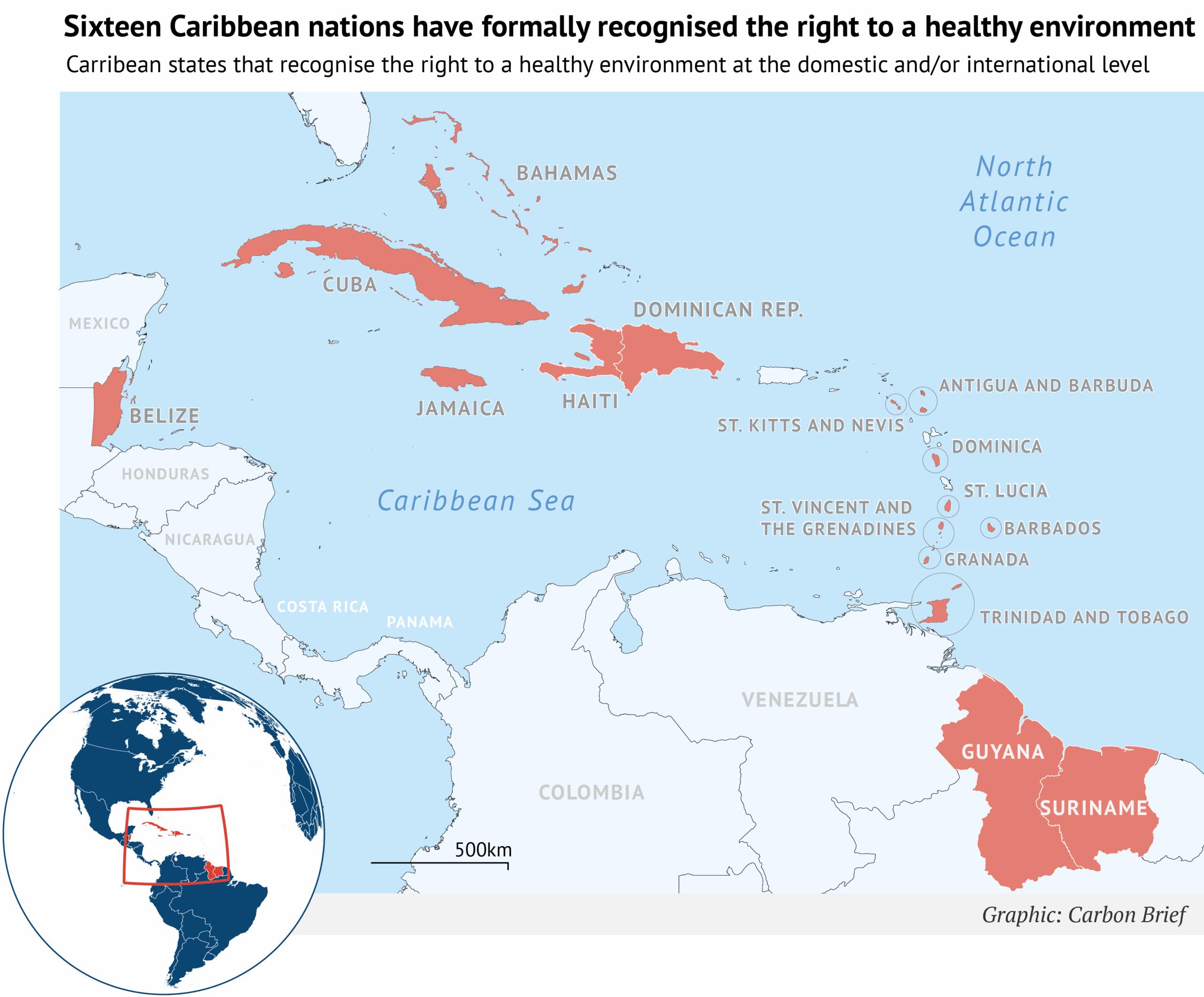
More recently, there has been a notable rise in targeted, sector-specific climate frameworks that go beyond broader environmental statutes.
Saint Lucia stands out as the only country with a climate framework law, or a comprehensive national law that outlines long-term climate strategies across multiple domains. Meanwhile, several other Caribbean governments have adopted climate-specific laws that focus on individual sectors, such as energy, migration and disaster management.
According to our analysis, more than a quarter of climate-relevant legislation in the region – comprising 21 laws and legally binding decrees – now has an explicit focus on climate change, as illustrated in the chart below.
Our research suggests that this represents an ongoing shift in legislative focus, reflecting changes in how climate legislation is being structured in one of the world’s most climate-vulnerable regions.
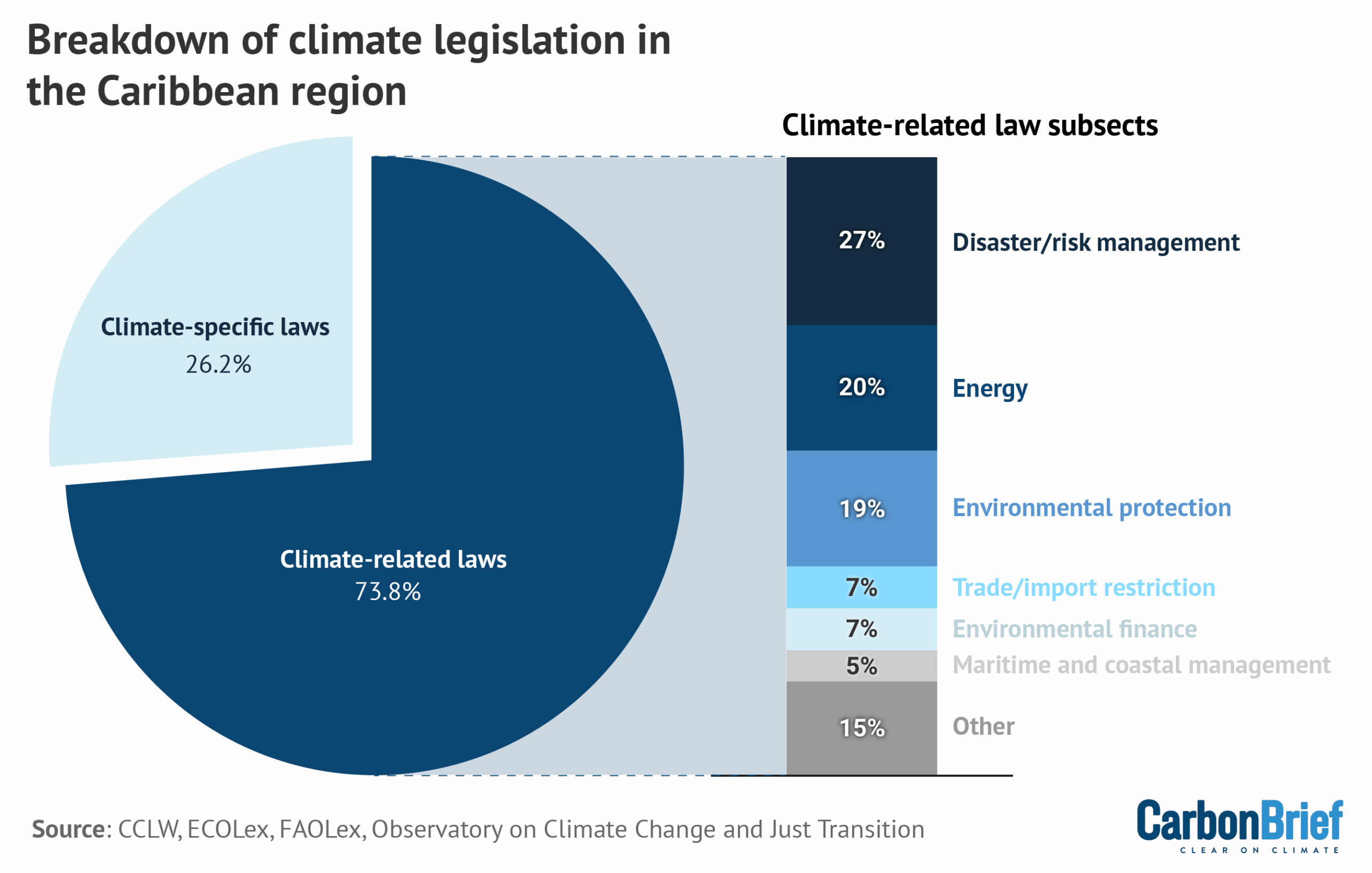
Caribbean nations are also advancing legal reforms to structure and institutionalise climate finance and market mechanisms directly into domestic law, aligned with Article 6.2 of the Paris Agreement.
For example, the Bahamas has introduced provisions for carbon credit trading, while Antigua and Barbuda, Barbados and Grenada have established national climate financing mechanisms to support mitigation and adaptation efforts.
Some states, including Belize and Saint Kitts and Nevis, have incorporated regional bodies such as the Caribbean Community Climate Change Centre – the climate arm of the intergovernmental Caribbean community organisation CARICOM – into national frameworks. This indicates an increasing alignment between regional cooperation and domestic law.
In addition to the influx of regulations specifically addressing climate change, Caribbean nations are also legislating broader environmental issues, which, in turn, could provide increased resilience from climate impacts and risks, as shown in the graph above.
Key trends in these types of climate-related laws include the expansion of disaster risk management governance, which addresses national preparedness for climate-induced weather events or related catastrophes. Likewise, energy law is an increasingly prominent focus, with countries including Antigua and Barbuda and Saint Vincent and the Grenadines integrating renewable energy and energy efficiency goals into national climate governance.
More broadly, many Caribbean nations have adopted wide-ranging and comprehensive environmental laws, many of which were developed in alignment with existing climate commitments. In combination, these legal developments reflect a dynamic and evolving climate governance landscape across the region.
Proactive vs reactive approaches
Despite general alignment with these broader regional trends, our research reveals distinct developmental pathways shaping domestic climate regulation.
In the eastern Caribbean, for example, we saw both proactive, long-term planning strategies and reactive, post-disaster reforms.
Saint Lucia’s multifaceted approach to climate resilience evolved steadily over the course of more than a decade. During this time, the country developed numerous adaptation plans, strengthened cross-sectoral coordination and engaged in institutional climate reforms in areas such as energy, tourism, finance and development.
More recently, the passage of Saint Lucia’s Climate Change Act in 2024 marked a milestone in climate governance, by giving legal force to the country’s obligations under the UNFCCC, the Kyoto Protocol and the Paris Agreement – making Saint Lucia one of the few small island states to incorporate global climate commitments into domestic law.
Our research indicates that this strategy has not only positioned the country as a more climate-resilient nation, but also solidified its access to international climate financing.
In contrast, Dominica’s efforts evolved more rapidly in the aftermath of Hurricane Maria in 2017, which destroyed over 200% of the country’s GDP. The storm’s impacts were felt across the country and hit particularly hard for the Kalinago people – the Caribbean’s last Indigenous community – highlighting the role of socioeconomic disparities in shaping climate vulnerability and resilience.
In response, the government passed the Climate Resilience Act, creating the temporary Climate Resilience Execution Agency for Dominica (CREAD).
Beyond establishing an exclusively climate-focused institution, the act aimed to embed resilience into governance by mandating the participation of vulnerable communities – including Indigenous peoples, women, older people and people with disabilities – in shaping and monitoring climate resilience projects.

As noted in a recent statement by the UN special rapporteur on Climate Change, Dr Elisa Morgera, these frameworks underscore the government’s ambition to become the world’s first “climate-resilient nation.”
Although challenges persist, Dominica’s efforts demonstrate how post-disaster urgency can drive institutional change, including the integration of rights and resilience into climate governance.
Uneven progress and structural gaps
Despite significant progress, our research shows that several key opportunities for climate governance across the Caribbean continue to exist, which could enable improvements in both resilience and long-term ambition.
The region’s legal landscape remains somewhat heterogeneous. While Saint Lucia has enacted a comprehensive climate framework law, the rest of the region lacks similar blanket legislation. This includes some states that entirely lack climate-specific laws, instead relying on related laws and frameworks to regulate and respond to climate-related risks.
Other nations have yet to adopt explicit disaster-risk management frameworks, leaving Caribbean populations vulnerable before, during and after climate emergencies. Most have yet to enshrine the right to a healthy environment at the national level.
Our research suggests that outdated legal frameworks are further limiting progress in addressing current climate risks. Because many of the longer-standing environmental laws in the region were adopted well before climate policy became a mainstream concern, some fail to address the nature, frequency and intensity of modern climate challenges, such as sea-level rise, tropical storms, wildfires, floods, droughts and other impacts.
More broadly, many Caribbean climate laws include limited integration of gender equity, Indigenous rights and social justice. As Caribbean nations such as Grenada and the Dominican Republic begin to link climate resilience with these issues, the region has an opportunity to lead by example.
Ultimately, capacity and resource constraints persist as significant barriers to implementation and adaptation.
The Caribbean region faces debt that exacerbates ongoing development challenges, a burden made heavier by the repeated economic shocks of climate-related disasters. Along with regional debt-for-resilience schemes, increased funding from high-emitting countries to support adaptation measures in climate-vulnerable nations – as endorsed under the Paris Agreement – is likely to be critical to ensuring the region’s climate laws can be executed effectively.
Global implications of Caribbean climate law
Our research suggests that Caribbean countries are outpacing other regions in terms of the scope and ambition of their climate laws. This legislation has the potential to serve as a model for climate-vulnerable nations worldwide.
Continuing efforts in the region show that legal frameworks in the field can not only drive resilience, embed rights and strengthen claims to international finance, but also highlight how regional cooperation and diplomacy can enhance global influence.
These findings demonstrate that innovation in climate law need not wait for action from major emitters, but can instead be led by those on the front lines of climate change.
The post Guest post: How Caribbean states are shifting climate legislation appeared first on Carbon Brief.
Guest post: How Caribbean states are shifting climate legislation
Greenhouse Gases
IEA: Renewables have cut fossil-fuel imports for more than 100 countries
More than 100 countries have cut their dependence on fossil-fuel imports and saved hundreds of billions of dollars by continuing to invest in renewables, according to the International Energy Agency (IEA).
It says nations such as the UK, Germany and Chile have reduced their need for imported coal and gas by around a third since 2010, mainly by building wind and solar power.
Denmark has cut its reliance on fossil-fuel imports by nearly half over the same period.
Renewable expansion allowed these nations to collectively avoid importing 700m tonnes of coal and 400bn cubic metres of gas in 2023, equivalent to around 10% of global consumption.
In doing so, the fuel-importing countries saved more than $1.3tn between 2010 and 2023 that would otherwise have been spent on fossil fuels from overseas.
Reduced reliance
The IEA’s Renewables 2025 report quantifies the benefits of renewable-energy deployment for electricity systems in fossil fuel-importing nations.
It compares recent trends in renewable expansion to an alternative “low renewable-energy source” scenario, in which this growth did not take place.
In this counterfactual, fuel-importing countries stopped building wind, solar and other non-hydropower renewable-energy projects after 2010.
In reality, the world added around 2,500 gigawatts (GW) of such projects between 2010 and 2023, according to the IEA, more than the combined electricity generating capacity of the EU and US in 2023, from all sources. Roughly 80% of this new renewable capacity was built in nations that rely on coal and gas imports to generate electricity.
The chart below shows how 31 of these countries have substantially cut their dependence on imported fossil fuels over the 13-year period, as a result of expanding their wind, solar and other renewable energy supplies. All of these countries are net importers of coal and gas.

In total, the IEA identified 107 countries that had reduced their dependence on fossil fuel imports for electricity generation, to some extent due to the deployment of renewables other than hydropower.
Of these, 38 had cut their reliance on electricity from imported coal and gas by more than 10 percentage points and eight had seen that share drop by more than 30 percentage points.
Security and resilience
The IEA stresses that renewables “inherently strengthen energy supply security”, because they generate electricity domestically, while also “improving…economic resilience” in fossil-fuel importer countries.
This is particularly true for countries with low or dwindling domestic energy resources.
The agency cites the energy crisis exacerbated by Russia’s invasion of Ukraine, which exposed EU importers to spiralling fossil-fuel prices.
Bulgaria, Romania and Finland – which have historically depended on Russian gas for electricity generation – have all brought their import reliance close to zero in recent years by building renewables.
In the UK, where there has been mounting opposition to renewables from right-wing political parties, the IEA says reliance on electricity generated with imported fossil fuels has dropped from 45% to under 25% in a decade, thanks primarily to the growth of wind and solar power.
Without these technologies, the UK would now be needing to import fossil fuels to supply nearly 60% of its electricity, the IEA says.
Other major economies, notably China and the EU, would also have had to rely on a growing share of coal and gas from overseas, if they had not expanded renewables.
As well as increasing the need for fossil-fuel imports from other countries, switching renewables for fossil fuels would require significantly higher energy usage “due to [fossil fuels’] lower conversion efficiencies”, the IEA notes. Each gigawatt-hour (GWh) of renewable power produced has avoided the need for 2-3GWh of fossil fuels, it explains.
Finally, the IEA points out that spending on renewables rather than imported fossil fuels keeps more investment in domestic economies and supports local jobs.
The post IEA: Renewables have cut fossil-fuel imports for more than 100 countries appeared first on Carbon Brief.
IEA: Renewables have cut fossil-fuel imports for more than 100 countries
-
Climate Change2 years ago
Spanish-language misinformation on renewable energy spreads online, report shows
-
Climate Change2 months ago
Guest post: Why China is still building new coal – and when it might stop
-
Climate Change Videos2 years ago
The toxic gas flares fuelling Nigeria’s climate change – BBC News
-

 Greenhouse Gases1 year ago
Greenhouse Gases1 year ago嘉宾来稿:满足中国增长的用电需求 光伏加储能“比新建煤电更实惠”
-
Greenhouse Gases2 months ago
Guest post: Why China is still building new coal – and when it might stop
-

 Climate Change1 year ago
Climate Change1 year ago嘉宾来稿:满足中国增长的用电需求 光伏加储能“比新建煤电更实惠”
-

 Carbon Footprint2 years ago
Carbon Footprint2 years agoUS SEC’s Climate Disclosure Rules Spur Renewed Interest in Carbon Credits
-
Renewable Energy3 months ago
US Grid Strain, Possible Allete Sale







